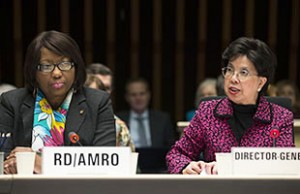
Director-General of the World Health Organization. (Photo from WHO website/courtesy WHO)
(Eagle News) – A committee from the World Health Organization (WHO) will convene today, Monday, February 1, to assess the Zika virus outbreak and to ascertain if it is already a public health emergency of international concern.
No less than WHO Director-General, Margaret Chan, will convene an International Health Regulations Emergency Committee on Zika virus and observed increase in neurological disorders and neonatal malformations.
The Committee will meet on Monday 1 February in Geneva to ascertain whether the outbreak constitutes a Public Health Emergency of International Concern, WHO said in a statement.
WHO director general Chan noted how the level of alarm concerning the Zika virus infections was “extremely high.”
She said this in a briefing on January 28 to the WHO Executive Board.
“Last year, the virus was detected in the Americas, where it is now spreading explosively. As of today, cases have been reported in 23 countries and territories in the region. The level of alarm is extremely high,” Chan said.
Chan traced the Zika virus infections.
She noted how the Zika virus was first isolated in 1947 from a monkey in the Zika forest of Uganda. Its historical home has been in a narrow equatorial belt stretching across Africa and into equatorial Asia.
For decades, the disease, transmitted by the Aedes genus of mosquito, slumbered, affecting mainly monkeys. In humans, Zika occasionally caused a mild disease of low concern.
In 2007, Zika expanded its geographical range to cause the first documented outbreak in the Pacific islands, in the Federated States of Micronesia. From 2013-2014, 4 additional Pacific island nations documented large Zika outbreaks.
In French Polynesia, the Zika outbreak was associated with neurological complications at a time when the virus was co-circulating with dengue. That was a unique feature, but difficult to interpret.
She said the present situation is “dramatically different.”
She said decisions concerning the Committee’s membership and advice will be made public on WHO’s website.
Outbreak in the Americas
WHO said that the first reported case of Zika virus disease was in Brazil in May 2015. Since then, the disease has spread within Brazil and to 22 other countries and territories in the region.
Arrival of the virus in some countries of the Americas, notably Brazil, has been associated with a steep increase in the birth of babies with abnormally small heads and in cases of Guillain-Barré syndrome, a poorly understood condition in which the immune system attacks the nervous system, sometimes resulting in paralysis.
A causal relationship between Zika virus infection and birth defects and neurological syndromes has not been established, but is strongly suspected.
WHO action
WHO’s Regional Office for the Americas (PAHO) has been working closely with affected countries since May 2015. PAHO has mobilized staff and members of the Global Outbreak and Response Network (GOARN) to assist ministries of health in strengthening their abilities to detect the arrival and circulation of Zika virus through laboratory testing and rapid reporting. The aim has been to ensure accurate clinical diagnosis and treatment for patients, to track the spread of the virus and the mosquito that carries it, and to promote prevention, especially through mosquito control.
The Organization is supporting the scaling up and strengthening of surveillance systems in countries that have reported cases of Zika and of microcephaly and other neurological conditions that may be associated with the virus. Surveillance is also being heightened in countries to which the virus may spread. In the coming weeks, the Organization will convene experts to address critical gaps in scientific knowledge about the virus and its potential effects on fetuses, children and adults.
WHO will also prioritize the development of vaccines and new tools to control mosquito populations, as well as improving diagnostic tests.
Chan said “a causal relationship between Zika virus infection and birth malformations and neurological syndromes has not yet been established, but is strongly suspected.”
“The possible links, only recently suspected, have rapidly changed the risk profile of Zika, from a mild threat to one of alarming proportions. The increased incidence of microcephaly is particularly alarming, as it places a heart-breaking burden on families and communities,” said the director general of WHO.
Chan said WHO is deeply concerned about this rapidly evolving situation for 4 main reasons:
- the possible association of infection with birth malformations and neurological syndromes
- the potential for further international spread given the wide geographical distribution of the mosquito vector
- the lack of population immunity in newly affected areas
- and the absence of vaccines, specific treatments, and rapid diagnostic tests.
She said that moreover, conditions associated with this year’s El Nino weather pattern are expected to increase mosquito populations greatly in many areas.
“The level of concern is high, as is the level of uncertainty. Questions abound. We need to get some answers quickly,” Chan said.
She said that this was why she has decided to convene an Emergency Committee under the International Health Regulations, which will meet today, Monday, 1 February.
“I am asking the Committee for advice on the appropriate level of international concern and for recommended measures that should be undertaken in affected countries and elsewhere. I will also ask the Committee to prioritize areas where research is most urgently needed.”
(with a statement from the World Health Organization)







